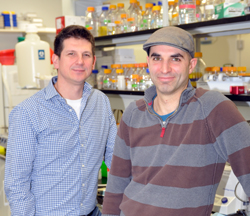
Photo: IRCM
A team of researchers at the IRCM led by Michel Cayouette, PhD, and Adjunct Professor in the Department of Medicine (Division of Experimental Medicine) and the Department of Anatomy and Cell Biology at McGill University, identified one of the genes responsible for producing a type of cell required for vision. The breakthrough, published in the scientific journal Neuron, could eventually help overcome obstacles associated with treatments to prevent blindness.
The retina of the eye is made up, in part, of two types of photoreceptors (light-sensing neurons): rods that enable night vision, and cones that are used for high visual acuity and colour daylight vision. The loss of cones is a major cause of blindness associated to various retinal degenerative diseases, and the scientific community is working towards restoring sight through cell replacement therapies.
“Retinal stem cells produce all types of retinal cells, including rod and cone photoreceptors,” explains Pierre Mattar, PhD, first author of the study and postdoctoral fellow in Dr. Cayouette’s laboratory. “The scientific community has been successful in generating rods from stem cells and has even used them to restore sight in mouse models of blindness, which shows that this approach is promising. However, the production of a large number of cones continues to be very difficult, for reasons that remain unknown.”
